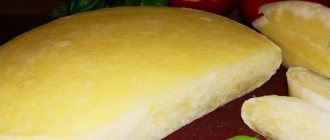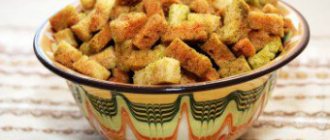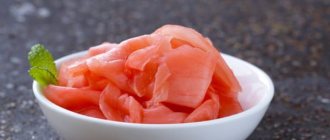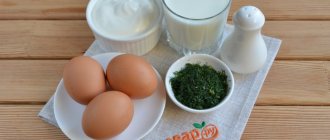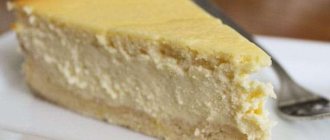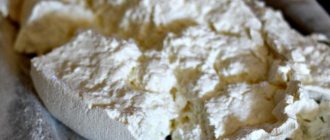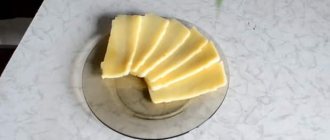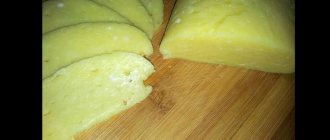Suluguni is a pickled cheese originally from Georgia, it has a sour-milk, moderately salty taste and smell. The consistency of Suluguni cheese is quite dense and at the same time elastic. GOST on Suluguni allows light layering of cheese on the surface. In accordance with the traditional recipe, this cheese is made only with natural leaven using rennet.
Suluguni cheese is actively used in cooking, usually used to prepare various baked goods. In this collection, our chefs share recipes for Suluguni dishes with photos and step-by-step instructions.
Sort recipes by .
What to cook from suluguni? Recipes in the section: 46 pcs.
The fact of the famous Georgian longevity is associated with the consumption of healthy products, including cheese. Among them, a worthy place is given to brined suluguni cheese, which is actively used in cooking. Recipes for dishes with suluguni are endlessly varied and incredibly tasty. Their origins go back to ancient times.
Historical perspective
For the first time, the ancestors of the Colchis kingdom, bordering the Abkhaz lands, began to make Sulugunis. In the region of Samegrelo the name is pronounced as “selegin”: sele - knead, gin - cow. Another etymology includes two words: created from whey." A beautiful legend connects the origin of the name with the soul (suli) and heart (guli).
Interesting Facts. There is an ancient tale about suluguni aged in homemade grape vodka. During the invasion of the Turkish army in Samegrelo, local residents, saving provisions, hid suluguni in barrels of chacha. Muslim Turks did not drink alcohol and did not pay attention to containers with forbidden drinks. This is how the old recipe has survived to this day.
Technological process
The ability of milk to quickly sour in hot climates decided the fate of the product. When the fermented drink is heated, a dense mass is obtained. It is ground and then pressed into a small amount of whey. The next stage is the process of melting the raw materials cut into ropes. A homogeneous viscous mass is born at a temperature above 70 degrees with continuous stirring.
The finished substance is cut into portions and placed in cylindrical molds, as shown in the photo. To cool, cheese balls are dipped in cold water and then placed in a saline solution for several days.
The result is white or pale yellow cheese. The consistency can be soft or hard, but always in the form of puff pastry. The structure of suluguni allows you to prepare anything from the finished ingredient: salad, soup, fried, smoked, baked cheese with vegetables, whose excellent taste is combined with nutritional value.
Interesting Facts. 2011 is considered the official worldwide recognition of the product. A patent was received for the production of real Suluguni cheese.
Suluguni recipe at home
Suluguni cheese is a pickled cheese; it is white and yellowish in color and has a layered structure and a distinct creamy taste.
Traditionally, suluguni is made from cow or buffalo milk.
High-quality Suluguni springs slightly when pressed.
The cheese dough may flake slightly, and whey will release between the layers when pressed. This is a sign of freshness.
The energy value of suluguni cheese is approximately 250-290 kcal per 100 g.
The recipe for suluguni cheese at home is as simple as the recipe for homemade hard cheese.
To do this, it will be necessary to perform four steps: ripening in whey, melting, molding and salting the cheese.
Ingredients for 1 kg of suluguni:
- 10 liters of milk
- 1 g pepsin (the enzyme is sold in pharmacies or specialty stores)
- 1 cup milk for starter
We recommend buying rennet from our online store.
How to cook suluguni at home:
1. To get a cheese starter, dilute 1 gram of pepsin in a glass of milk at room temperature.
2. Strain the milk through cheesecloth or a fine sieve. Then put on fire in a non-enamel bowl and heat to 30 degrees.
3. Add cheese starter to the heated milk and leave for half an hour in a warm place.
4. After 30 minutes, return the milk to low heat. As the mass curls, it will need to be collected against one wall of the dish. It will take you about 5 minutes
5. Squeeze out the resulting lump of excess whey and place in a shallow bowl. Then place in a colander and let drain a little.
6. Leave the young cheese to ferment in a small amount of whey for several hours in a warm room.
7. After a few hours, check whether the young cheese is ready for further processing. To do this, cut a strip of cheese and dip it in heated water for a few minutes.
If the strip of cheese stretches easily but does not tear, then you can continue preparing the suluguni.
8. Cut the cheese into ribbons two centimeters thick. Heat water in a saucepan to 80-90 degrees.
9. Place the cut cheese in water until it melts. Cook the resulting mass over low heat and stir with a wooden spatula in one direction.
10. When the cheese has melted, remove the pan from the heat. Form the cheese mass into a lump, remove it from the pan and shape it into a circle. Just be careful, don't forget that the cheese is very hot.
Then cool the resulting head of cheese by dipping it in cool water. Suluguni is ready.
As you already understand, even a beginner in cheese making can make Suluguni cheese on their own.
You can buy a mold for Suluguni cheese in the online store with delivery by Russian Post.
Previous article: Jamie Oliver's cheese fondue Next article: Marinated cheese. Recipe for marinated cheese
Beneficial features
The protein contained in cheese recipes is easier and more fully digestible than in meat and fish.
Advice. It is customary to treat cheese as a dessert and start eating it after the main meal. Food eaten before cheese dessert is better absorbed.
Suluguni has a beneficial effect on the digestive system and increases performance. It contains:
- vitamins A, B1, B2, B12, C, PP, D, E;
- phosphorus, zinc, selenium, magnesium, calcium, iron, copper.
Useful elements stabilize the functioning of the body:
- metabolism improves;
- water balance is normalized;
- cholesterol is removed from the blood;
- the cardiovascular and central nervous systems are strengthened;
- calcium strengthens nails, teeth, bone tissue.
Advice. It is recommended to widely include suluguni cheese dishes in the diet of children, nursing mothers, pregnant women, patients with low acidity, chronic diseases, and it is eaten for tuberculosis.
Energy value of suluguni composition per 100 grams:
- calorie content – 328 kcal;
- proteins – 22 g;
- fats – 18 g;
- carbohydrates – 22.5 g.
A product with low calorie content is preferred by fashionistas to maintain their figure.
Suluguni is consumed both as an independent food and as part of a variety of dishes. There are no limits to imagination for Suluguni cheese and recipes with it.
Melted suluguni at home
To prepare this type of suluguni you need the following:
- milk - 2.8–3 liters;
- pepsin - on the tip of a knife;
- ordinary water - 1.9 liters;
- salt - 70 g.
Cooking will take 15-16 hours.
100 grams of melted suluguni contains 290 kcal.
How to make processed suluguni cheese at home:
- Milk poured into a saucepan is brought to 45⁰;
- Pepsin is dissolved in 25 ml of cold water;
- Next, the dissolved pepsin is poured into the milk and mixed. Turn off the heat, cover the pan with a lid and leave for half an hour;
- After 30 minutes, the cheese is tested for elasticity: run a knife or spoon over its surface; if it “springs”, then cut the cheese and leave for another 25 minutes, and then mix;
- Next, the cheese is placed on cheesecloth, the liquid is squeezed out and left hanging for 1.5 hours;
- Meanwhile, salt is dissolved in water, and then the cheese is immersed in this brine. Leave it for 5 hours at room temperature;
- After a while, the cheese is cut and poured with boiling water until it is completely immersed;
- In boiling water, the cheese will begin to melt, so you need to stir it to achieve homogeneity of the product;
- Then, the cheese again needs to be hung in gauze for 1.5 hours;
- Afterwards, prepare a new saline solution and place the suluguni in it for 6 hours. After which it is completely ready for use
Dough dishes and suluguni
Flour products are loved and eaten not only in their native country, but also outside of Georgia. Our housewives learned how to cook the main national pastry - khachapuri, adding their own nuances to the recipe.
Khachapuri in Adjara
The dough in this recipe uses yeast dough with the composition:
- milk – 2 glasses;
- sunflower oil – 1 cup;
- 3 tbsp. spoons of sugar;
- 1 packet of instant yeast.
- suluguni – 150 g;
- boiled egg – 2 pcs.;
- fresh egg - according to the number of servings.
Suluguni with lemon juice
Adding lemon juice during the preparation of Georgian suluguni helps to quickly separate the whey from the cottage cheese.
To prepare suluguni based on it, you will need the following components:
- milk - 2 liters;
- lemon juice - 60 ml;
- iodized salt - 75 g.
It will take 8 hours to prepare.
270 kcal per 100 g of cheese.
Recipe for homemade suluguni with lemon juice step by step:
- Milk is heated in a saucepan to 40⁰;
- As soon as the first bubbles appear, lemon juice and 15 g of salt are poured into the milk (this will speed up the separation of the curd from the whey);
- When the first curd flakes form on the surface of the milk, turn off the heat, cover the pan with a lid and simmer for 5 minutes;
- The cottage cheese is collected and placed on gauze prepared in advance. The cottage cheese is wrapped in it and left hanging for 1.5 hours;
- While the remaining whey drains from the curd, prepare a new portion of brine from the remaining 60 g of salt and 2 liters of water. It is better to start making it as soon as the whey begins to flow less and less;
- After the allotted 1.5 hours, the cottage cheese is removed from the gauze and placed in brine. Leave it there for 6 hours. After which, the finished cheese is completely ready.
Benefits of Suluguni cheese
Before we figure out what dishes can be prepared from Suluguni cheese, let’s find out what the features of this variety are.
Most nutritionists claim that pickled cheeses, which includes suluguni, are superior to hard varieties in terms of beneficial properties. This is due to the fact that they contain less fat and carbohydrates, and therefore their calorie content is lower. 100 grams of Suluguni cheese contains 286 kcal. This is a lot, but 1.5 times less than, for example, in Gouda and Russian cheese.
Therefore, while following a dietary diet, if it is not possible to completely exclude cheese from the menu, then eating suluguni in small quantities is acceptable.
Suluguni cheese with sour cream at home
To prepare suluguni according to this recipe, you will need sour cream with high fat content (more than 30%).
Ingredients:
- sour cream - 230 ml;
- milk - 2.2 liters;
- chicken egg - 4 pcs;
- fresh dill - 1 bunch;
- salt - 40 g;
- seasonings are at your discretion.
Cooking time: 7–8 hours.
The calorie content of the product per 100 g will be 290 kcal.
Recipe for making suluguni cheese with sour cream step by step:
- Milk is poured into a deep saucepan and heated over moderate heat until the first bubbles appear. Afterwards, reduce the heat and add salt while stirring;
- Pour sour cream into another container, beat eggs into it, and mix everything thoroughly, bringing it to a homogeneous consistency;
- The resulting mixture is slowly added to the milk;
- The dill is washed, chopped finely and added to milk; seasonings can also be added;
- As soon as the milk begins to curdle, turning into cottage cheese, simmer it for a few more minutes (5-6) over low heat;
- The resulting cottage cheese is placed on cheesecloth spread in a colander. Leave the product for 25 minutes to allow all the liquid to drain;
- Next, the gauze is folded into a bag, the remaining liquid is manually squeezed out, and then placed in a deep container, covered with a plate, on top of which a bottle of water (5 liters) is placed;
- Leave the cheese in this position for 3–5 hours, periodically draining the accumulated liquid;
- Ready suluguni should be kept in the refrigerator for some time before serving.
What to cook with suluguni: recipes for popular dishes
There are various recipes for dishes using Georgian cheese. You can make hot sandwiches from it and use it as a salad component. It is even possible to make desserts and cakes with suluguni. We offer popular options for dishes using Georgian cheese.
Recipe for fried suluguni cheese
One of the quick recipes is fried suluguni cheese. This is a delicious snack that can complement fresh vegetable salads.
To prepare fried Georgian cheese you will need the following ingredients:
- cheese – 200 grams;
- chicken egg - 1 piece;
- flour – 3-5 tablespoons;
- breadcrumbs – 3-5 spoons;
- vegetable oil – 50 ml.
- Cut the product into portions.
- Prepare 3 deep containers: 1 - with flour, 2 - with a beaten egg mixed with salt and seasonings to taste, 3 - with breadcrumbs.
- We first dip each piece of cheese in the egg, then roll it in flour, then again in the egg, and finally bread the cheese with breadcrumbs.
- Fry the prepared pieces of suluguni in a frying pan on both sides until golden brown.
Advice! To prevent suluguni from leaking during frying, it is recommended to thoroughly bread the pieces of cheese and keep them in the pan as little as possible. That is, we fry suluguni in hot oil.
- Place the fried cheese on a plate with napkins to remove excess vegetable oil.
In a similar way, it is possible to deep-fry suluguni. The dish is served hot. Any sauce will go well with fried suluguni: garlic, sour cream, cheese, with herbs, etc.
Pie with suluguni from lavash in a slow cooker
A simple and at the same time very tasty dish that does not require any special culinary skills from the home cook.
Let's take the following ingredients:
- thin sheet Armenian lavash - 3 pieces;
- suluguni – 200 grams;
- dry cottage cheese – 200 grams;
- kefir – 500 ml;
- chicken egg - 3 pieces;
- butter – 50 grams.
Also in the housewife's arsenal there should be a multicooker, several containers and a wooden spatula. By the way, the filling can consist exclusively of Georgian cheese, with the addition of your favorite herbs and spices.
Let's start cooking:
- Take a deep container, beat the eggs into it, add kefir and beat them with a whisk. Salt the kefir-egg mixture and pepper to taste.
- Grind the suluguni on a coarse grater or separate it into fibers. It all depends on the type of cheese.
- Grease the multicooker container with butter. Place 1 sheet of pita bread on the bottom of the container so that its edges cover the walls and protrude beyond the edges of the multicooker bowl.
- Tear another sheet of lavash into small pieces. Cover the bottom of the multicooker, lined with lavash, with another layer of torn lavash, previously soaked in the egg-kefir mixture.
- Mash the cottage cheese with a fork and mix it with the cheese. On top of the pita bread we spread a thin layer of cheese base, on top of which again goes torn pita bread dipped in the egg-kefir mixture. Using the principle of alternating layers, we continue to form our pie until the ingredients run out.
- Place a whole sheet of lavash on top of the filling, wrapping its edges inside the pie. Pour the remaining kefir-egg mixture on top and place a piece of butter on the pie.
- Bake the cake in the Baking mode. Cooking time – 40-50 minutes.
- After the specified time has passed, place the steaming tray in the multicooker and turn the bowl over so that the cake remains on the tray. It is advisable to carry out these manipulations over a dish, since residual oil may leak out of the pie. Now carefully return the pie to the slow cooker, crispy side up. Bake for 40-50 minutes in the same mode.
Leave the finished pie in the bowl for a quarter of an hour, and then take it out. The dish can be served immediately after preparation.
Recipe for making suluguni at home
So, if you have Imeretian cheese, let’s start cooking.
Ingredients:
- Imeretian cheese;
- water;
- salt.
Cooking technology:
First of all, it is recommended to check the Imeretian cheese for readiness: cut off a small piece of Imeretian cheese and put it in hot (~90°C) water.
While it warms up (3-5 minutes), put on gloves: first cotton, then rubber. This way we can work comfortably with hot water.
The bottom line is this: if the cheese after heating becomes plastic and begins to stretch, then everything is fine - you can safely start preparing suluguni.
- Cut the Imeretian cheese into pieces measuring approximately 1 by 1 cm and place them in a separate cup.
- We boil a sufficient amount of water in which we will keep the cheese pieces until they soften and form a single mass.
- After the water has boiled, pour it into a container with cheese pieces and leave for about 5 minutes so that the pieces have time to warm up. Then mix.
Our goal at this stage is to ensure that the cheese pieces are completely melted in the water. Therefore, in order to constantly keep them at a high temperature, from time to time you should drain the cooled water and replace it with hot water. This must be done until a single melted mass is formed.
- After the cheese mass sticks together into a homogeneous piece, drain off the remaining whey. Now our task is to form a layered structure for our product. To do this, roll out the cheese with your hands and then fold it. We repeat the simple procedure for a couple of minutes, after which we transfer the almost finished product into the mold.
- Leave it for 10 minutes at room temperature to allow excess water to drain, then put it in the refrigerator to cool for 1-2 hours.
- The last stage is the ambassador. Place the cheese in a 20% saline solution (200 g of salt per 1 liter of water) and put it in the refrigerator overnight.
